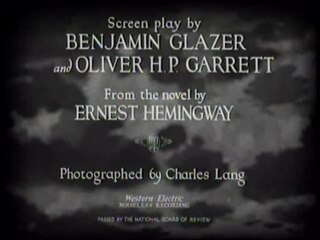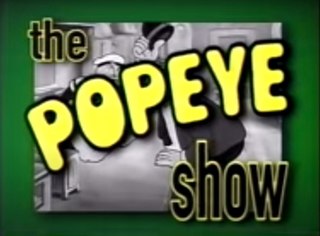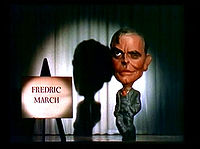
A film crew is a group of people, hired by a production company, for the purpose of producing a film or motion picture. The crew is distinguished from the cast, as the cast are understood to be the actors who appear in front of the camera or provide voices for characters in the film. The crew is also separate from the producers, as the producers are the ones who own a portion of either the film studio or the film's intellectual property rights. A film crew is divided into different departments, each of which specializes in a specific aspect of the production. Film crew positions have evolved over the years, spurred by technological change, but many traditional jobs date from the early 20th century and are common across jurisdictions and filmmaking cultures.
A screenplay, or script, is a written work by screenwriters for a film, television show, or video game. A screenplay written for television is also known as a teleplay. Screenplays can be original works or adaptations from existing pieces of writing. A screenplay is a form of narration in which the movements, actions, expressions and dialogue of the characters are described in a certain format. Visual or cinematographic cues may be given, as well as scene descriptions and scene changes.
A film producer is a person who oversees film production. Either employed by a production company or working independently, producers plan and coordinate various aspects of film production, such as selecting the script, coordinating writing, directing, editing, and arranging financing.
"Below-the-line" is a term derived from the top sheet of a film budget for motion pictures, television programs, industrial films, independent films, student films and documentaries as well as commercials. The "line" in "below-the-line" refers to the separation of production costs between script and story writers, producers, directors, actors, and casting and the rest of the crew, or production team.
A title sequence is the method by which films or television programmes present their title and key production and cast members, utilizing conceptual visuals and sound. It typically includes the text of the opening credits, and helps establish the setting and tone of the program. It may consist of live action, animation, music, still images, and/or graphics. In some films, the title sequence is preceded by a cold open.

Closing credits or end credits are a list of the cast and crew of a particular motion picture, television program, or video game. Where opening credits appear at the beginning of a work, closing credits appear close to, or at the very end of a work. A full set of credits can include the cast and crew, but also production sponsors, distribution companies, works of music licensed or written for the work, various legal disclaimers, such as copyright and more.

In a motion picture, television program or video game, the opening credits or opening titles are shown at the very beginning and list the most important members of the production. They are now usually shown as text superimposed on a blank screen or static pictures, or sometimes on top of action in the show. There may or may not be accompanying music. When opening credits are built into a separate sequence of their own, the correct term is a title sequence.

Rankin/Bass Animated Entertainment was an American production company located in New York City, and known for its seasonal television specials, usually done in stop motion animation. Rankin/Bass' stop-motion productions are recognizable by their visual style of doll-like characters with spheroid body parts and ubiquitous powdery snow using an animation technique called "Animagic".

A trailer is a commercial advertisement, originally for a feature film that is going to be exhibited in the future at a movie theater/cinema. It is a product of creative and technical work.
Filmmaking is the process by which a motion picture is produced. Filmmaking involves a number of complex and discrete stages, starting with an initial story, idea, or commission. It then continues through screenwriting, casting, pre-production, shooting, sound recording, post-production, and screening the finished product before an audience that may result in a film release and an exhibition. Filmmaking occurs in a variety of economic, social, and political contexts around the world. It uses a variety of technologies and cinematic techniques.

Billing is a performing arts term used in referring to the order and other aspects of how credits are presented for plays, films, television, or other creative works. Information given in billing usually consists of the companies, actors, directors, producers, and other crew members.
A production company, production house, production studio, or a production team is a studio that creates works in the fields of performing arts, new media art, film, television, radio, comics, interactive arts, video games, websites, music, and video. These groups consist of technical staff to produce the media, and are often incorporated as a commercial publisher. Generally the term refers to all individuals responsible for the technical aspects of creating a particular product, regardless of where in the process their expertise is required, or how long they are involved in the project. For example, in a theatrical performance, the production team has not only the running crew, but also the theatrical producer, designers and theatrical direction.
A film distributor is responsible for the marketing of a film. The distribution company may be the same with, or different from, the production company. Distribution deals are an important part of financing a film.

A production logo, vanity card, vanity plate, or vanity logo is a logo used by movie studios and television production companies to brand what they produce and to determine the production company and the distributor of a television show or film. Production logos are usually seen at the beginning of a theatrical movie or video game, and/or at the end of a television program or TV movie. Many production logos have become famous over the years, such as the 20th Century Studios's monument and searchlights and MGM's Leo the Lion. Unlike logos for other media, production logos can take advantage of motion and synchronized sound, and almost always do.

U.M. & M. TV Corporation was an American media company best known as the original purchaser of the pre-October 1950 short films and cartoons produced by Paramount Pictures, excluding Popeye and Superman. The initials stand for United Film Service, MTA TV of New Orleans, and Minot T.V.
Television crew positions are derived from those of film crew, but with several differences.

The Popeye Show is an American cartoon anthology series that premiered on October 29, 2001, on Cartoon Network. Each episode includes three Popeye theatrical shorts from Fleischer Studios and/or Famous Studios. The show is narrated by Bill Murray, who gives the audience short facts about the history of the cartoons as filler material between each short. Animation historian Jerry Beck served as a consultant and Barry Mills served as writer and producer. A total of 45 episodes were produced, consisting of a total of 135 shorts.
Edgar J. Scherick was an Emmy-winning American television executive and producer of television miniseries, made-for-television films, and theatrical motion pictures.

A film – also called a movie, motion picture, moving picture, picture, photoplay or (slang) flick – is a work of visual art that simulates experiences and otherwise communicates ideas, stories, perceptions, feelings, beauty, or atmosphere through the use of moving images. These images are generally accompanied by sound and, more rarely, other sensory stimulations. The word "cinema", short for cinematography, is often used to refer to filmmaking and the film industry, and to the art form that is the result of it.
A line producer is a type of film or television producer who is the head of the production office management personnel during daily operations of a feature film, advertisement film, television film, or TV program. A line producer usually works on one film or episode of a TV program at a time. They are responsible for human resources and handling any problems that come up during production. Line producers also manage scheduling and the budget of a motion picture, as well as day-to-day physical aspects of the film production.











